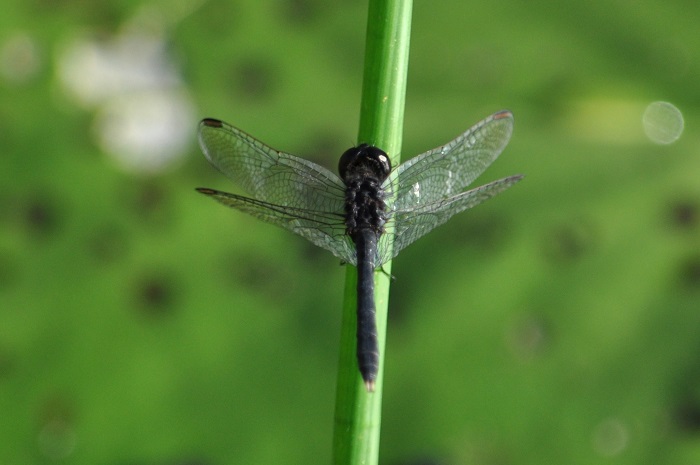Cover photo by Alan Manson.
Find this species in the FBIS database (Freshwater Biodiversity Information System) here.
Family Libellulidae
Identification

Near Himeville, KwaZulu-Natal
Photo by Alan Manson
Very Small size
Length up to 25mm; Wingspan attains 46mm.
Confusion with the Dwarf Percher is only likely with Diplacodes lefebvrii (Black Percher). Mature males of the two are very similar, being an overall black colour with blackish eyes and a dark metallic blue frons. The Black Percher is the larger species with little to no size overlap between them. Additionally mature male Black Perchers have white cerci and small dark amber patches at the base of the hindwings. These are mostly absent in the Dwarf Percher. Diplacodes pumila also has a ‘large headed’ appearance
Immature males of D. lefebvrii and D. pumila are easily told apart. The upper thorax of D. lefebvrii is yellow-brown with fine black etching. The upper thorax of D. pumila is rusty red-brown and diagnostic. Diplacodes pumila has a very broad black stripe that extends down the length of the abdomen. This stripe is noticeably thinner in D. lefebvrii.
Dwarf Percher females are similar to the young males. They are identified by the diagnostic, rusty red-brown upper thorax and the broad black stripe that extends down the top of the abdomen.
Click here for more details on identification.

Near Himeville, KwaZulu-Natal
Photo by Alan Manson
Habitat
The Dwarf Percher inhabits shallow marshes, seeps and floodplains. It prefers sites with tall emergent grass, sedges, and reeds. In South Africa, the Dwarf Percher is most often found at fairly high altitudes in upland grasslands, from 1000 to 2100m above sea level, but is found along the coast in north-eastern KwaZulu-Natal.

Photo by Ryan Tippett
Behaviour
The Dwarf Percher is an inconspicuous species that likes to sit low down among the emergent vegetation. Males and females occur in the same areas.
Status and Conservation
The Dwarf Percher is uncommon and localised in South Africa. It is listed as Endangered in the IUCN Red List of Threatened Species. The Dwarf Percher is mostly reliant on high quality natural habitats, but is known to utilise suitable marshy habitats fringing man-made dams.

Hluhluwe district, KwaZulu-Natal
Photo by Ryan Tippett
Distribution
The distribution of Diplacodes pumila is widely scattered across south-central Africa from central Angola to northern Zambia, and marginally into neighboring DRC and Tanzania. The Dwarf Percher also occurs in parts of Zimbabwe and South Africa.
The South African range of the Dwarf Percher is disjunct, occurring in coastal north-eastern KwaZulu-Natal as well as at various upland sites in KwaZulu-Natal, Mpumalanga and Limpopo.
Below is a map showing the distribution of records for Dwarf Percher in the OdonataMAP database as at February 2020.

Below is a map showing the distribution of records for Dwarf Percher in the OdonataMAP database as of December 2024.

The next map below is an imputed map, produced by an interpolation algorithm, which attempts to generate a full distribution map from the partial information in the map above. This map will be improved by the submission of records to the OdonataMAP section of the Virtual Museum.


Ultimately, we will produce a series of maps for all the odonata species in the region. The current algorithm is a new algorithm. The objective is mainly to produce “smoothed” maps that could go into a field guide for odonata. This basic version of the algorithm (as mapped above) does not make use of “explanatory variables” (e.g. altitude, terrain roughness, presence of freshwater — we will be producing maps that take these variables into account soon). Currently, it only makes use of the OdonataMAP records for the species being mapped, as well as all the other records of all other species. The basic maps are “optimistic” and will generally show ranges to be larger than what they probably are.
These maps use the data in the OdonataMAP section of the Virtual Museum, and also the database assembled by the previous JRS funded project, which was led by Professor Michael Samways and Dr KD Dijkstra.
Further Resources
The use of photographs by Alan Manson is acknowledged. Other photographs by Ryan Tippett.
Dwarf Percher Diplacodes pumila Dijkstra, 2006
Other common names: Dwergsittertjie (Afrikaans)
Recommended citation format: Loftie-Eaton M; Navarro R; Tippett RM; Underhill L. 2025. Dwarf Percher Diplacodes pumila. Biodiversity and Development Institute. Available online at https://thebdi.org/2020/06/18/dwarf-percher-diplacodes-pumila/
References: Tarboton, M; Tarboton, W. (2019). A Guide to the Dragonflies & Damselflies of South Africa. Struik Nature.
Samways, MJ. (2008). Dragonflies and Damselflies of South Africa. Pensoft
Samways, MJ. (2016). Manual of Freshwater Assessment for South Africa: Dragonfly Biotic Index. Suricata 2. South African National Biodiversity Institute, Pretoria

